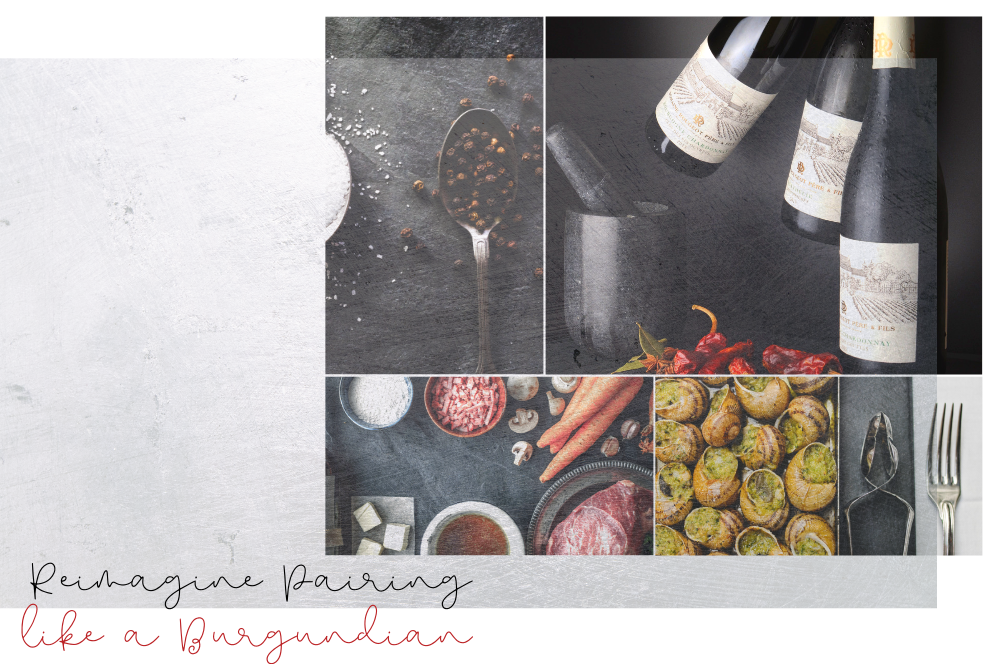Whether you start off with the wine or with the recipe, the science of pairing wine with food heightens any tasting experience. Too often restricted to the covert whisperings between chefs and sommeliers, pairing brings out complimentary dimensions and congruent flavours in both the wine and food. The prospect of choosing from the numerous possible combinations, so as to create the “perfect pairing”, can sometimes seem a daunting task. Are you looking to host a monumental dinner party, or liven a quiet Tuesday evening? Fear no longer. In this article, we will use the region of Burgundy to inspire you to pair for any occasion.
France is famous for its wine regions, and one of the greats is undoubtedly Burgundy. Its classics are cherished worldwide, but the region also has some unlikely delights to uncover. With these simple key steps, we can all learn how to pair like a Burgundian.

A Pair of Pairings: Contrast vs Congruent.
In order to find that special partnership we need to look at certain aspects in both the wine and the dish:
- Texture: What is the consistency of a dish? How does the wine feel on the palette?
- Acidity: Is there a high level of acidity?
- Sweet or Bitter: What part does sugar play? Is there bitterness present?
- Flavour profiles: What are the distinguishing profiles, salt, spice, umami, aromatic, floral…
- Flavour intensity: Does a certain flavour dominate? Is there a natural balance?
Once you have these answers you can decide whether you want to build a contrasting or congruent pairing...
|
CONGRUENT emphasise shared qualities and compounds to enhance a mutual flavour palette |
CONTRAST highlight different, yet complementary characteristics and flavour profiles in the wine and food, to create an overall balanced tasting experience |
For example, a creamy risotto could pair well with a voluptuous Viognier to enhance the textural tactility of the dish, creating a congruent pairing. Alternatively, a zingy zesty Chablis would bring striking contrast to the richness of the meal by refreshing the palette.
ATTENTION!
With both pairings it's important to pay attention to balance. If a certain flavour dominates, it must not overpower its pairing partner. For example, a spicy curry would overpower the delicacy of a light bodied Pinot Noir. Equally pairing a sweet wine with a very sweet dessert would create a sugar overload. However, sweet wines are excellent with spicy foods: both are bold and characterful, but the spice is complemented by the sweetness of the wine.

Get Saucy…
Never forget the importance of sauces! When analysing a recipe you might look to the principal element such as the meat, or fish. Whilst this can affect the choice of wine, the sauce is far more important. The sauce acts as the flavour base for any dish, and is often what competes with the wine the most. You might first assume that fish should always be paired with white wine, however, a dish such as baked cod in a red wine and garlic sauce would overpower a white, and therefore demands a light bodied red.
Curating a Classic Palette.
When looking at food and wine pairings, we can go further to elevate the experience with global curation of multiple courses and wines. If you are going to serve more than one dish with different wines, the progression of the meal is as important as the individual selections. There should always be a natural crescendo of intensity. This can be achieved either by having a recurring element which links each dish, or allowing the palette to develop with the previous flavour profile, leading on to the next. For example, if you were to start with a full-bodied Syrah followed by a delicate Muscadet, it would create a harsh juxtaposition and the residual flavours of the former could affect the latter.
Don’t be obvious! Think like a Burgundian.
The big AOPs of Burgundy are known worldwide: Meursault, Chablis, Montrachet, Gevrey-Chambertin etc. However, as a local Burgundian you can’t drink Romanée Conti every night, so it's necessary to know the hidden secrets of the region. Here are three quirky curiosities of the Burgundy vineyard:
- Passe-Tout-Grains is a fabulous weekday red. Unlike its 100% Pinot Noir counterparts, Passe-Tout-Grains is a blend of Gamay, Pinot Noir, and sometimes up to 15% of Chardonnay, Pinot Blanc, or Pinot Gris. As a regional AOP it can be produced anywhere across Burgundy, however, is mainly found in the Côte Chalonnaise. Its name comes from the technique of coplantation, which certain winemakers adopted to grow different types of vines alongside each other. With glints of lilac and fuchsia, this light bodied, fruit forward red expresses cassis, raspberry and gooseberry. It is an excellent Tuesday apéritif pairing with a pork terrine.
- Aligoté is both the name of a varietal and a regional AOP in Burgundy. It is an easy drinking weekday white and favourite among the Burgundians. However, on quality terroir more complex and aged Aligotés can also be found. This pale yellow and gold white wine offers aromas of peach, acacia and green apple. With its fruity acidity, it pairs perfectly with oysters on a Wednesday night.
- Saint Bris is perhaps the most surprising of the three. The AOP was only recognised in 2003 and is located in the village of Saint-Bris-le-Vineux in the department of Yonne, near Chablis. Although a significant majority of white wine in Burgundy is made from Chardonnay, this special oddity can be a blend of Sauvignon Blanc and Gris. Unlike any other Burgundy wine, the crisp climate of Yonne creates a Sauvignon similar to that of a Sancerre. Saint-Bris’ are usually a light straw yellow, and have an expansive aromatic range or grapefruit, mandarin and lychee and would elevate a Thursday fish curry.
The Burgundy Classic.
One of the most popular Friday classics for a local Burgundian is Cuisses de Grenouille: lightly fried frog legs in garlic and parsley. This French favourite hails from Burgundy, and so what better pairing than a glass of Côte de Beaune. The bright notes of lemongrass and yellow apple compliment the parsley and refresh the palette, while the gentle undertones of honey and almond embellish the sweet and delicate meat.
And voila! By following these tips you can live like a Burgundian every night of the week!
Harriett Gifford is a freelance English writer based in Paris, France. A classicist, graduate of Le Cordon Bleu and a lover of natural wine.



